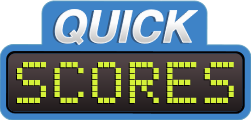Advantage & Disadvantage
It is important to know the intent and purpose of a rule. A team and player should not be given an advantage, not intended by a rule. Conversely, a team and player should not be placed at a disadvantage not intended by a rule.
Beginning the Game
Prior to beginning a game, an equal number of dodgeballs are placed along the center line on each side of the center hash mark. A standard game consists of 6 balls, 3 on each side of the hash mark. Teams may position the balls in any way they choose.
Players then take a position behind their end line.
Following a signal by the official, teams may approach the centerline to retrieve the balls. Teams may only retrieve balls placed to the right (as they face the centerline) of the center hash mark. If balls remain on the centerline after a team has retrieved and moved their balls beyond the attack line, those balls may be retrieved by the opposing team after five seconds (as counted by the Referee).
False Start is called if players cross their end line prior to the official’s signal to start the game. Result: Play is stopped and one ball from the offending team’s side is moved to the opponent’s side of the hash mark. Repeat for each infraction.
Blocking
A player may block a thrown ball with a ball being held, provided the holder does not lose control of the held ball as a result of the contact with the thrown ball.
- The held ball does not need to strike the ground to cause the holder to be out, only be knocked loose of the holder’s grip. Even if the holder regains control of the held ball, they are still out. Any actions by the holder after the initial loss of control are ignored.
- A player may drop the ball with which they have blocked in order to catch a deflected ball. Officials must be sure to recognize the difference between a loose ball and an intentionally dropped ball. A loose or dropped ball contacting a live ball causes it to become dead.
Number Of Players
Dodgeball is played by two teams, each made up of six players. Teams are made up of 6 to 10 players. Each game begins with 6 players competing on a side; others are available as substitutes.
Object
The object of the game is to eliminate all opposing players by getting them out.
Outs
An out is scored by:
- Hitting an opposing player with a live thrown ball
- Catching a live ball thrown by your opponent.
- Causing an opponent to lose control of a held ball as a result of contact by a thrown live ball. Even if the player regains control of the ball before it strikes the ground, the player is still out (Usually occurs when a held ball is being used to block a thrown ball)
- An opposing player stepping out of bounds. (see Rule 1, Section 3)
Live (def.): A thrown ball that strikes or is caught by an opposing player without or before contacting the ground, another player, a non-held ball, official or other objects.
Head hits count as a hit, though any player determined to be purpose-fully aiming at other players’ heads be given a technical foul.
A live ball deflecting off a held ball or striking the holder remains live only to the holder. Following the deflection or striking of the holder,
A live ball deflecting off the body of Player “A” remains live only to Player “A”. If “A” legally catches the deflected ball, the thrower is out. Team-mates of “A” may not legally catch the deflected ball. In fact, touching of the deflected ball by another player causes it to become dead. Once a player is out, they must drop any balls in hand and exit the playing field at the nearest sideline. If an out player intentionally contacts a live ball before exiting the playing field, the opponents are awarded a free throw.
Referees
The primary responsibility of a referee is to:
- signal the start and end of games
- signal timeouts
- keep time
- track eligible players
The secondary responsibility of a referee is to:
- the rule in cases where teams cannot agree
Because of this, referees must attempt to observe all the action on the court. Although it may not be possible to see all questionable plays, the referee should allow teams to reach a decision, before making an official “call.” Even if a referee clearly observes a player not going out after being legally hit or stepping out of bounds, they must resist making a call until an official request is made. (Referees who observe abuse of the honor system may recommend a technical foul on a player to the league coordinator). When a player requests that a referee makes a call, play should be stopped and the referee should make one of three calls:
- The player is out,
- The player is not out, or
- Didn’t see the play – play on.
Regardless of the call, play continues with no further discussion of the play or call.
Play continues until the monitor’s signal. A player’s request does not stop play – the referee’s signal does.
All contests are supervised by a referee. Rules are enforced primarily by the honor system. Players are expected to rule whether or not a hit was legal or whether they were legally eliminated. Exception: During tournament play, All Semi-Final and Final round matches are officiated by no less than 2 officials. These officials rule in all situations.
Rules
Based on the National Amateur Dodgeball Association (NADA) Rules. The purpose of the rules is to create a balance of play; provide reasonable safety and protection; and create an atmosphere of sportsmanship and fair play without unduly limiting freedom of action of an individual or team play.
Sides
The Referees determine the side each team starts on. Teams alternate sides following each game.
Substitutes
Substitutes may enter the game only during time-outs, or in the case of injury.
If the team in question has less than 7 players, they may use a registered substitute. All registered substitutes must meet the following criteria:
- The player must be in the same or below age/grade as the division for which they wish to play.
- The team on which the registered substitute wishes to play must agree to use this player as a substitute.
- Substitutes cannot be used if there are 7 or more registered players present for that team.
- Substitutes can only sub for a team for a max of 3 weeks.




